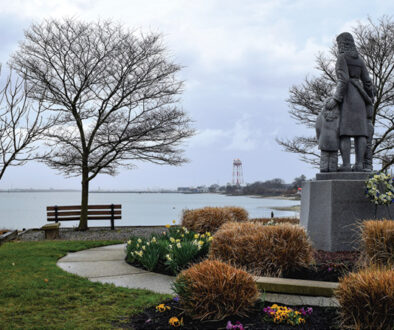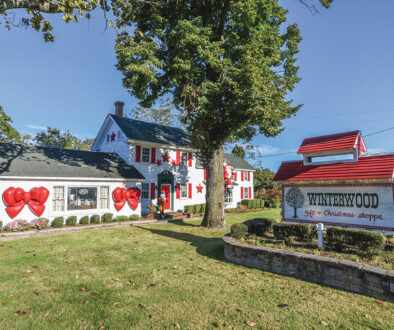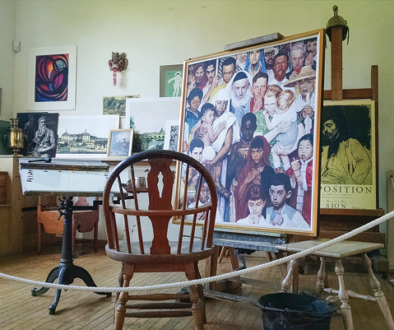A Coast Guard Family Legacy Of Service & Saving Lives

In a Coast Guard town like Cape May many tales are told about old salts and their adventures at sea. But this story, about an extended Coast Guard family, is one for the history books.
Llewellyn “Lew” Midgett was among the first young men to finish boot camp when the Coast Guard Training Center was established in Cape May in 1947. He was in the fifth company to train, graduating in 1948. He was 17 when he enlisted, and had never been away from home. “I boarded an overnight train in Norfolk for Philadelphia,” he says, “then caught a train to Cape May. It was an old coal burner and it stopped at every pig pen along the way. By the time we got to Cape May, we were covered with soot.”
Lew Midgett grew up in Manteo, on Roanoke Island in the Outer Banks, North Carolina. To live on this small island is to live with the sea. It is but 12 miles long and two miles wide, wrapping around Shallowbag Bay. In the early years, waterfront buildings had two doors, one for arriving by boat, the other for walking in off the street. “The town was so isolated.” he says. “I grew up with no electricity, no telephone or indoor plumbing, not until the 1940s.” He says he had only two choices. “Be a fisherman or join the Coast Guard. It was an easy decision. I was a teen in World War II. I heard booms in the night, the island shook when German U-boats hit off shore. I couldn’t wait to join the military. I enlisted in the Coast Guard just as soon as I could.” That was 70 years ago.
This year, Retired U.S. Coast Guard Chief Warrant Officer Llewellyn Daniel Midgett, now age 86, was invited to Washington, D.C., and honored at the Pentagon. His Cape May family, including daughter and granddaughter, were in the audience.
The May 19th ceremony was designed to celebrate a milestone in military history. More than 200 members of the Midgett family have been engaged in U.S. lifesaving services since the late 1800s. The Coast Guard Historical Office says the Midgett family legacy is unprecedented. None of the other four military branches has had so many members of one extended family serve the country for so many years. Members of the Midgett family (also spelled Midgette) have performed duties in the U.S. Life-Saving Service, the U.S. Lighthouse Service, and the U.S. Coast Guard. Records show that in 1972, there were 30 Midgetts—all at one time—active in the Coast Guard. It was a family tradition; sons followed fathers. Lew Midgett’s father, Franklin Harris Midgett, served in the Coast Guard from 1920 to 1945. He started out as a surfman at lifesaving stations on the Outer Banks.
Part of the reason for their seafaring aptitude is geographical. The Midgett family has lived on the Outer Banks, famous for shipwrecks, since the 1700s. The area off the coast is called “The Graveyard of the Atlantic.” There are two strong rivers at sea that collide near Cape Hatteras. The cold water Labrador Current from the north meets the warm Gulf Stream from the south, and the conflicting currents churn up fierce storms. Ships navigating storm-tossed seas tend to draw nearer the shoreline and encounter Diamond Shoals, a series of always shifting underground sandbars which come and go, depending on tides and weather. There is a long history of high winds and heavy seas overpowering ships, smashing them onto sandbars or flat beaches. According to the Cape Hatteras National Seashore Park, more than 1,000 dead ships still reside in The Graveyard of the Atlantic.
From this seascape the Midgett family learned the lessons of the perilous local waters and became expert in navigating and at saving lives. Midgetts were rescuing ship-wrecked mariners and passengers decades before there was an official, organized lifesaving service. Once the U.S. Life-Saving Service (1848-1915), the U.S. Lighthouse Service (1910-1939), and the U.S. Coast Guard (1915) were established, members of the Midgett family served in all three of these guardians of the sea.
The first Midgett serving in an official government capacity was L. Bannister Midgett. He was appointed a keeper of the Outer Banks lifesaving station at Little Kinnakeet in 1874. Three other Midgetts became keepers at that same post through 1915. Facing Pamlico Sound, it was southernmost of the seven original lifeboat stations on the Outer Banks, 11 miles north of Cape Hatteras Light, which was manned by members of the Midgett family.
Bannister Midgett also served at Chicamicomico Life-Saving Station at Rodanthe, North Carolina, 13 miles from the Bodie Island Light. He was profiled in a 1974 book, The Mighty Midgetts of Chicamicomico, by Nell Wise Wechter. She wrote about three Midgett keepers of the station: Cap’n Ban, Cap’n John Allen, and Cap’n Levene. They served for all of the 78 years the station stayed in commission. The author noted the name Midgett outnumbered all other names when the United States first counted Outer Banks citizens in 1790. It’s believed the originals, arriving in the early 1700s, were possibly survivors of a British ship wreck. Their speech had touches of Elizabethan English. A genealogy study claimed that they originated in France, but centuries ago had migrated to England where they built ships.
The book relates that Cap’n Ban was notorious for going barefoot. “Old timers swore he could strike a long-stemmed sulfur match on the bottom of his naked foot.” Cap’n Ban claimed to be illiterate, blaming “the treasonable neglect of the Confederacy to maintain schools during the Rebellion.” However, as a matter of fact and record, the book says that Cap’n Ban read widely and wrote fluently in private. It was only in public that he assumed the posture of an unlettered man. It saved him a lot of bother inherent in the keeping of government records and carrying on official correspondence. He was of the opinion that Washington, D.C. “was skewered through and through with office ink pens and bound hand and foot with red tape.”
Cap’n Ban is described as: “A mighty man with an oar, no doubt about it. He was a surfman and the oar was part of him. His legend grew from Wimble, next to the Diamond Shoals, which is as dangerous a place as there is on the Eastern Seaboard. Scores of ships have died there. But because Cap’n Ban, and others like him, had an instinctive knowledge of the sea and how to use an oar in a boat, hundreds of men were saved.” In his Chicamacomico Wreck Report Journal, Cap’n Ban recorded more than 100 entries of lives saved.
One hair-raising episode with the sea in 1881 bears out his great courage and bravery, according to the book. “The schooner Thomas J. Lancaster became stranded and was breaking up. The captain’s children had been washed overboard. His wife and others had been lashed to the port fore rigging. The wind blew at 75 miles per hour. Cap’n Ban and his surfmen worked all night and finally were able to get a surfboard out to the schooner where they rescued survivors from the rigging. They held on like bulldogs against the raging ocean until they brought the victims safely into their surfboat.”
Boyhood experiences from this environment and stories of his legendary family are what Lew Midgett carried with him in his 30 years of service in the Coast Guard. His favorite duty was on the Coast Guard cutter Ingham. “At one time on the Ingham,” he says, “there were 16 other men from my home county Dare, and five from my hometown Manteo. The salt and sea are borne in our blood.” Midgett says it was on the Ingham he began his path to becoming an engineer as a boiler tender specialist.
He returned to Cape May in 1951 as a boiler tender. “There was but one taxi service in town,” he says. “For a quarter, you could get a ride downtown to buy a hamburger or hotdog. Not much going on then. It was real quiet except for the wind. The town hadn’t changed since I was in boot camp.” When he was assigned extended shore duty, he discharged in protest. “I hated shore duty. I wasn’t going to do it. I wanted to be at sea.” He re-enlisted in less than a month with the goal of going back to sea on the Ingham which he did, again as a boiler tender. After duty in Baltimore, Norfolk, Elizabeth City and Wilmington, North Carolina, and Londonderry, Connecticut, Lew Midgett returned to Cape May in 1964. Aboard the Coast Guard cutter Unimak, he was in charge of all the piping—water, fuel and oil systems.
During his four years in Cape May, his daughter Elizabeth “Gayle” attended Lower Cape May Regional High School. As happens in many Coast Guard families, she met the love of her life, a local guy, Don Noland. She stayed on in Cape May in 1968 when her father made chief and transferred to Brooklyn. She married her high school sweetheart, and has made Cape May her home ever since. Both her daughter Tracey Martin (executive assistant to Curtis Bashaw, Cape Resorts) and granddaughter Bridget Martin graduated from Lower Cape May Regional.
The family had a reunion in Cape May this summer when Bridget graduated. Grandpa Lew and his wife Joy drove to town from Wilmington, North Carolina, in a 30-foot RV, pulling along his pickup truck.
They relaxed at granddaughter Tracey’s home for some reminiscing about the Midgetts’ hometown, Manteo. Grandpa Lew is considering returning there to live, in a new condominium development, not far from where he grew up on Little Street, now called Wingina Avenue.
“Three years ago at Christmas,” Lew recalls, “they asked me to come back to my old family house, sit on the couch and tell stories, for people attending the holiday house tour.” The home has been completely restored, and is considered one of the historical houses in town.
“In the old days, before electricity, radio and TV, Pop would go out at night, look up at the stars, come in and tell us the weather for tomorrow. The old timers could feel hurricanes and nor’easters comin’, and they could tell you just how rough it was going to be. We never worried much about storms. There was the time the sea surged around our house and we had to evacuate to the second floor of the old lifesaving station on Bodie’s Island. We never thought much about the lifesaving, either. It’s just what we did when you had to do it.”
The Midgett name became nationally known with the christening of the Coast Guard cutter Midgett honoring Chief Warrant Officer John Allen “Bos’n” Midgett Jr., who spent 40 years in the U.S. Life-Saving Service and Coast Guard. He was a member of the Outer Banks Midgett family, born in 1876 in Rodanthe, Cape Hatteras Island. The 378-foot cutter Midgett was launched in September, 1971. The cutter was named for him for “his extreme and heroic daring” in rescuing 42 crewman aboard the British tanker Mirlo. It was torpedoed by a German U-boat in 1918 during World War I. The tanker, loaded with gas and oil, exploded, bursting into flame, the fire spreading over 10 miles of sea. The crew abandoned the burning ship in three boats: the first capsized. Bos’n Midgett and his crew, despite rough seas, pulled the men from the burning water and secured the two lifeboats onto their craft and brought all the British sailors to safety. Bos’n Midgett was awarded the Gold Lifesaving Medal, the country’s highest award for saving a life. Among the crew that night were four other Midgetts: Zion, Arthur, Clarence, and Leroy, as well as Prochorous O’Neal, who was married to a Midgett. All received the American Cross of Honor.
Grandpa Lew told his family gathered in Cape May this summer that in 1972, after the cutter Midgett had been commissioned, it anchored in Morehead City, North Carolina for a special Midgett Day celebration. “All the Midgetts who had ever been in the Coast Guard and their families were invited for the day. I was on the cutter Cherokee as associate engineer. We were getting ready to head out. I had an invitation to the celebration, but I said to the captain, ‘I am going to sea.’ The captain said, ‘You had a letter from the admiral inviting you to Midgett family day, and you are going to go.’ So I did, and I was pleased I did so. The whole deck was full of Midgetts. It was so amazing, the National Geographic ran a photo of all the Midgetts aboard the cutter. I was standing between Jack Midgett, the commander at the time, and a cousin, the three of us there on the bow.”
This May, at the Washington, D.C. ceremony, Lew Midgett, with his grandson at his side, presented his officer’s ceremonial sword to be displayed in a Pentagon hall dedicated to the Coast Guard where other Midgett family honors have been placed.
And, as is tradition of the family, 11-year-old grandson Michael Midgett says he is planning to follow in Grandpa and Great-Grandpa’s footsteps and join the Coast Guard.











